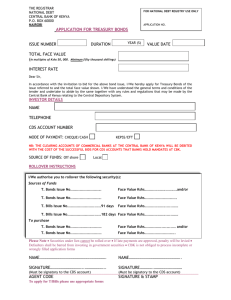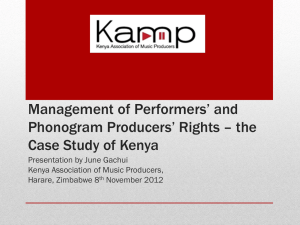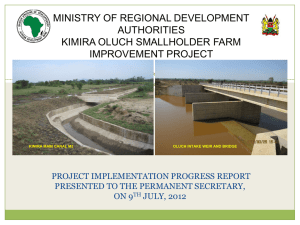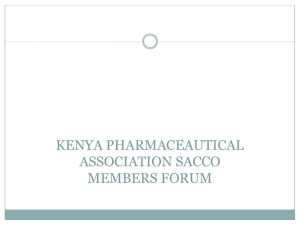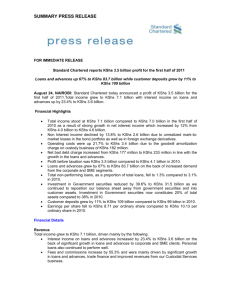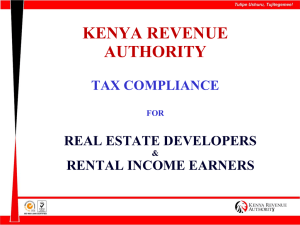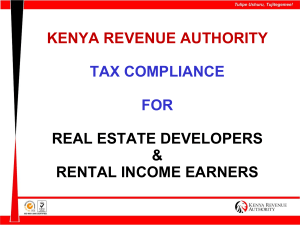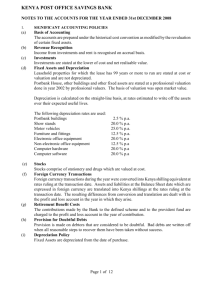Richard E. Ndubai - Performance Management Division
advertisement
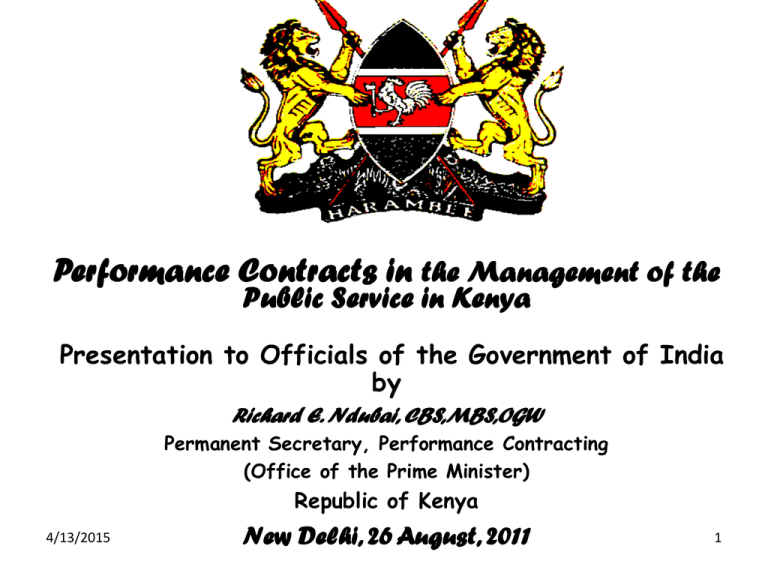
1 Performance Contracts in the Management of the Public Service in Kenya Presentation to Officials of the Government of India by Richard E. Ndubai, CBS,MBS,OGW Permanent Secretary, Performance Contracting (Office of the Prime Minister) Republic of Kenya 4/13/2015 New Delhi, 26 August, 2011 1 PRESENTATIONS I. Performance Contracting in Kenya; II.Citizens’ Service Charters III.Performance Appraisal Systems Scope of Presentation • Background to Introduction of PCs • Overview of PSR in Kenya • What is a Performance Contract? • Citizens’ Service Charter • Experiences, Lessons & Challenges Introduction & Background In 2003 new Government ►inherited • Public Service • Mainstream Civil Service with ministries; • 130 Public Enterprises; • 175 Local Authorities • Staff strength of about 700,000 32 Introduction & Background Did not have: 1. a clear mission; 2. a shared vision; 3. none of the ministries had a strategic plan; 4. over 70% of state corps, and all 175 local authorities did not have strategic plans; 5. no clear strategic direction; An economy growing at 0.4%! 4/13/2015 5 Introduction & Background Public service: a. b. c. d. e. regarded corporate governance as a private sector affair; determination of performance was based on how well processes and activities were carried out; Serious problem of lethargy and inefficiency; Lost public trust, and Even had problems with utilization of resources! Introduction and Background • In the 2004/05 FY, the Treasury released KShs299.065billion to all ministries. Out of this, some KShs34.2billion or 11.4% was however returned unutilised by the end of the FY; • 14 Ministries were not able to spend large portions of the funds given by Treasury in 2004/05. They therefore surrendered back the indicated proportion of their funding to Treasury: MINISTERIAL EXPENDITURES 2004/2005 (KSH MILLION) No Ministry/Dept Actual Exchequer Funds released Actual Utilised % Actual Utilised Actual Returned % Actual Returned 1 National assembly 5,500 4,375 80 1,125 20 2. DPM 2,157 1,306 61 851 39 3. Planning and Natl. Devpmt. 2,138 1,471 69 667 31 4. Regional Devpmt. 833 492 59 341 41 5. Agriculture 6,570 3,084 58 2,766 42 6. Local Government 7,240 3,954 55 3,286 45 7. Transport 4,652 3,525 76 1,127 24 8. Justice and Const. Affairs 2,472 992 40 1,480 60 9. Fisheries and Livestock 3,332 2,095 63 1,236 37 10. Co-operative Dev. 2,044 625 31 1,419 69 11. East African Corporation 528 203 38 325 62 12 State Law Office 547 128 23 419 77 13 Trade & Industry 2,564 2,035 79 529 21 14. Information and Comm. 670 250 37 420 63 Introduction & Background Public sector had therefore become part of the bigger problem! a drain on the exchequer for financial support in form of grants and loans, Impediment to: economic growth recovery of the economy Introduction & Background Govt. quickly realized that problem emanated from: – Inefficient exploitation and use of public resources; – Unresponsive culture; service delivery Introduction and Background ∴ Need to reorient public sector management by introducing new systems & adopting best international practices to help to: a. Reengineer operations to keep ahead of growing public demand for better services; Introduction and Background b. Reposition country on the growth trajectory; c. Create competitive advantage for the country d. Restore trust in Government, & dignity of the public service; Key Issue? Performance Improvement • Issue – establishing a performance management system; • System which focuses on appropriate leadership and development of “people” capacities; 4/13/2015 13 People & Institutions? “an empowered organization is one in which individuals have the knowledge, skill, desire and opportunity to personally succeed in a way that leads to organizational success” Stephen Covey 4/13/2015 14 People, Institutions, Systems? But Why “System”? 4/13/2015 15 Determinants of Performance People 80% 20% Leader R E S T Determinants of Performance Economic Growth 8 7.1 7 6.3 5.8 6 % 5.6 5 4.3 4 2.8 3 2.6 1.7 2 1 0.4 0 2002 2003 2004 2005 Year 2006 2007 2008 2009 2010 Stark Realities A. Efficiency of the public service defines and informs the efficiency of all other sectors of an economy. . “The quality of an effective Government can not be lower than that of its clients – specifically the private sector” ► Malaysian Prime Minister, Mahathir Mohamad, Stark Realities B. Obstacles to performance problems do not lie necessarily with comparative disadvantage in resource endowment; not even with funding deficits; but, because of: i). Hanging onto the same/old ways of doing things and of solving problems; ►you cannot expect different results by persistently applying the same techniques to solve problems 4/13/2015 20 Stark Realities C. an agency requires a clear strategic direction to achieve its objectives. “If you do not know where you are going, any there”. 4/13/2015 road will take you 21 22 Stark Realities 4/13/2015 D. that Government Will be Improved Only When We: i. recognize that we do produce outputs and that what we do can be measured, managed and improved; ii. discover that we have real customers, with all the rights and privileges that the word “customer” bestows, and that the satisfaction of our customers is absolutely essential to our success. 4/13/2015 22 Stark Realities F. Countries in the world can be classified according to their ability to implement policies and programs; Implementation depends on effective followup (M&E) (another name for accountability) Effectiveness of follow-up and monitoring depends on quality and not quantity of M&E (Effective evaluation requires explicit rankings). Stark Realities • Foundation of competitive advantage for a country is Public Service Efficiency; Q Q why Public Service Efficiency? how do we create, develop & sustain public service efficiency? 4/13/2015 WHY PUBLIC SERVICE EFFICIENCY? To Fulfill Obligations to Citizen: 1.deliver top quality, affordable, accessible & timely services; 2.efficient exploitation & utilization of public resources; 3.engender accountability & transparency in the utilization of public resources; 4/13/2015 WHY PUBLIC SERVICE EFFICIENCY? 4. create enabling environment for economic & social activity; 5. Ultimate: • fast-track economic growth; • create wealth and employment • improve citizen welfare; 4/13/2015 26 Public Sector Reforms in Kenya In Kenya PSR began soon after independence and: • aimed at improving the quality of the lives of its citizens; • targeted at elimination of poverty, disease, hunger and ignorance, achieving social justice, human dignity and economic welfare for all. Public Sector Reforms in Kenya • exploring new pathways to promoting good governance and sustainable democracy through the adoption and implementation of pro-change policies: Public Sector Reforms in Kenya Thrust: 1) Reorganizing the governance machinery to achieve higher levels of competence, transparency and accountability, and to minimize waste in government spending; 2) Inculcating ethics and new value systems of honesty, probity, patriotism and respect for the nation’s diversity; Public Sector Reforms in Kenya 3) Enlisting the support of stakeholders from the private and other sectors, to participate in growing the national economy; 4) Changing the role of the state from that of a sole provider of employment and services, to the new role of creating an enabling environment for wealth and employment creation; Public Sector Reforms in Kenya 5) Creating a lean, efficient and working government, and, by curtailing wasteful public expenditure, freeing resources to fund development programs and people issues; 32 Reform Strategies 4/13/2015 5-year strategic plan ► Economic Recovery Strategy for Wealth and Employment Creation, (ERS). • The strategy recommended sweeping reforms in the management of the public service observing that, “…the problems attributed to the many state corporations arise from the lack of clear performance contracts that facilitate the monitoring of the performance of the CEOs appointed to manage the corporations” Reform Strategies ERS ►Reorientation of public sector management by: Accelerating ministerial rationalization and developing strategic plans for ministries/departments & downstream institutions; Developing, introducing and institutionalizing performance based management practices in the public service; Reforms & Performance Contracting Govt. therefore introduced the following initiatives: Required public institutions to develop strategic plans by 2004; Introduced reforms to jumpstart management of the public service; Empowered citizens to demand excellent service as an entitlement. 4/13/2015 34 Reforms & Performance Contracting Adopted a two-pronged reforms approach; Capacity Building (tooling & re-tooling) & Behavior Change Shift focus from Processes/Activities to results, outputs & outcomes Performance Contracts This approach gave rise to the Performance 4/13/2015Contract 35 PERFORMANCE OF MINISTRIES 0.42 0.42 0.41 0.41 Composite scoring 0.40 0.40 0.39 0.39 0.38 0.38 0.37 0.37 2005/06 2006/07 2007/08 Period 2008/09 2009/10 PERFORMANCE OF STATE CORPORATIONS 0.43 0.42 Composite scoring 0.41 0.40 0.39 0.38 0.37 0.36 2005/06 2006/07 2007/08 Period 2008/09 2009/10 PERFORMANCE OF LOCAL AUTHORITIES 0.34 0.34 0.33 Composite scoring 0.33 0.32 0.32 0.31 0.31 0.30 0.30 0.29 2006/07 2007/08 Period 2008/09 2009/10 PERFORMANCE OF TERTIARY INSTITUTIONS 0.39 Composite scoring 0.39 0.38 0.38 0.37 0.37 0.36 2008/09 2009/10 Period 40 So, What is a Performance Contract (PC)? 4/13/2015 • A PC is a freely negotiated performance agreement between Government, acting as the owner of an Agency, and the management of the Agency; ► a range of management tools used to define responsibilities and expectations between parties to enable them achieve mutually agreed results; ∴ Specifies what needs to be achieved, expected levels of achievement, timelines, evaluation and reporting methodologies; 4/13/2015 40 41 What is a PC? 4/13/2015 ►organizes & defines tasks so management is able to perform them systematically, purposefully & with reasonable probability of achievement. • Makes it possible to measure: –Performance of a public institution; –Performance of manager; –Performance of the government 4/13/2015 41 What is a PC? • Privatizing the public sector style of management for purpose of: – Retaining for public benefit, or – Disposing at higher return Performance Contract Key objectives are to: 1. Increase efficiency & productivity in public sector; 2. ensure maximum yield to the citizen, on the tax shilling; 3. ensure that performance and results link with stakeholder expectations; 4. Create Global Competitiveness for a country; 4/13/2015 43 Performance Contract 5.Link the benefits of economic growth to the grass root levels; 6.Increase Customer (Public) Satisfaction with Government Services; 7.Build and sustain trust in Government; 8.Create wealth and improve the quality of lives of citizens. 9. Link reward to measurable performance in public service; 4/13/2015 44 10. cascade national policy priorities to public agencies for implementation VISION 2030 MINISTERIAL MANDATE MISSION Strategic Objectives Performance Criteria Performance Targets Performance Contract 11. ensure linkage between planning, budgeting and results; 12. enable monitoring and measurement of performance; 13. enhance service delivery 47 Performance Contracts 4/13/2015 PC process has endured 6 cycles with distinct impact on performance of the economy; 7th cycle PCs preparing for evaluation; Currently, a total of 470 public institutions on board; 4/13/2015 47 Performance Evaluation • The measurement of the extent to which public agencies achieve negotiated performance targets; • established using the equation below: • Managerial Performance = Agency Performance ± Exogenous Factors Performance Evaluation • Excellent: achievement ≥30% above the agreed performance target, • Very Good:Achievement between 100% and 130% of the performance target in the signed PC; • Good: Achievement between 70% and 100% of performance target in the signed PC; • • Fair: Achievement between 50% and 70% of the target in the signed PC; • • Poor: Achievement between 0% and 50% of the target in the signed PC. Experiences, Lessons & Challenges Learnt 4/13/2015 I. Initial Impact on Performance: 1st Cycle PCs 16 largely commercial pilot state corporations signed PCs on 1st October 2004; Generation of Pre-tax profits 50 Evaluation Results Performan Target Achievement % % ce Performance (KShs mil.) Change over Change 2003/04 (KShs mil.) Previous yr over Target 2,432.376 8,181.427 9,300.598 382.37% 13.68% 52 PERFOMANCE OF PILOT CORPORATIONS 4/13/2015 4000 3000 1000 ACTUAL(03/04) TARGET ACHIEVED -1000 -2000 -3000 STATE CORPORATION M TE LK O C K N O N H C L KW A KU C LC KP A KP C KP C KB KI E IC D C EA PC C 0 C SC PRE-TAX PROFITS (M KSH) 2000 53 4/13/2015 Performance Contract The PC focuses on 6 management perspectives which are assigned varying weights: Performance Criteria • 4/13/2015 1. 2. 3. 4. 5. 6. Finance & Stewardship Service Delivery Non-Financial Operations Dynamic/Qualitative Corruption Eradication 53 WT CRITERIA CATEGORY * A Financial & Stewardship Compliance with set budgetary levels Cost reduction/Savings KShs A-in-A KShs Utilization of Allocated Funds % Development index (DExp/RE) % % Debt equity ratio Weight Sub total Service Delivery Implementation of Service delivery Charters Customer Satisfaction Service Delivery Innovations Non-Financial Compliance with strategic plan Disposal of idle assets ISO Certification Corruption eradication Prevention of HIV infections Statutory obligations Operations Outputs: X Y Z Project implementation: - Timeliness - Quality - Relevance - Cost efficiency - Completion Rate Fulfilment of Performance Contract Commitments to State Corporations Treasury Representation in negotiation* E Weights Sub total Very Good (1.50 – 2.49) Good (2.50 – 3.49) Fair (3.50 – 3.59) Poor (3.60 – 5.00) Achievement Raw score 30 % % % % % % 10 Qty, etc % % % % % % % Weights Sub total Dynamic/Qualitative; • Organisational Capacity: - Skills Development - Automation (IT) - Work Environment (Baseline Survey / Implementation) Employee satisfaction Repair Maintenance Safety measures Submission of Pensions Documents to Pensions Dept Research and Development Prevention of Drug and Substance Abuse Excellent (1.00 – 1.49) % % No. Weights Sub total D CRITERION VALUES 20 Weights Sub total C Target % B UNIT Current Status 25 % % Time / % % % % % Months 54 % % 15 Weighted score 55 II. Impact on Service Delivery 4/13/2015 Citizens’ Service Charters Enhanced satisfaction with public services through: i. implementation of Citizen’ Service Charters and ii. the requirement to carry out annual Customer Satisfaction Surveys; Citizens’ Service Charter? Statement prepared by a public agency outlining the quality, quantity and nature of public service that the citizens expect from the agency. ► It sets out - what the public institution does, - what services users can expect, - the standard of service provided, - requirements to obtain service - details of any user charges, -how users may seek redress dissatisfied with the service provided. if they are DISTRICT LANDS OFFICE ►SERVICE DELIVERY CHARTER Services Rendered Requirements Charges Time Frame Enquiries (customer care desk) None. Free 10 min Provision of technical advice ( eg subdivision, charge, succession, transfer, caution etc) None. Free 30 min Issuance of title through adjudication, settlement or succession (In the case of issuance of title after sale, a valuation report will be required) Transfer document, Pin number, 2 sets of Passport size photographs for each party Original ID A valuation report Ksh 125 per title 2 days Assessment of stamp duty None. Free 30 min Valuation for stamp duty None. Free 3 days Stamping of documents None. Free 1/2 day Registration of documents: Transfers, Charges New grants Other documents Transfer document, Pin number, 2 sets of Passport size photographs for each party Original ID None. Ksh 250 Ksh 250 Ksh 250 2 days 2 days 1 day 5 days For the same transaction, customers will be required to submit only one set of documents Issuance of search certificate None. Ksh 100 1 hour Determination of boundary disputes Attendance by all parties. Ksh 1,250 2 weeks Review of caution Attendance by all parties Ksh 750 1 day Attendance to court None. Free As summoned Attestations None. Ksh 400 30 min Approval of subdivision schemes Prior approval by other relevant authorities. Ksh 125 per plot 2 days Approval of building plans Prior approval by other relevant authorities. Minimum Ksh 750 2 days Issuance of consent to transfer/ charge/ lease/let Confirmation of compliance with conditions of title. Ksh 250 per plot 2 days Comments on applications for extension of lease/user/subdivisions/ amalgamations Prior approval by other relevant authorities. Free 2 days Response to correspondence None Free “COMMITMENT TO COURTESY AND EXCELLENCE IN SERVICE DELIVERY” Any service that does not conform to the above standards or any officer who does not live up to commitment to courtesy and excellence in service delivery should be reported to: the District Land Officer/Registrar or the District Commissioner, and/or the Chief Executive Officer, Public Complaints Standing Committee (Ombudsman), Tel: 240337/224029/0722970604. The District land office is committed to efficient and effective land registration and management. IT IS YOUR RIGHT TO DEMAND EFFICIENT SERVICE “Huduma Bora ni Haki Yako” MINISTRY OF MEDICAL SERVICES CITIZENS’ SERVICE CHARTER FOR DELIVERY OF MEDICAL SERVICES FOR DISTRICT HOSPITALS This hospital and its staff are committed to provide high quality health care services to all our patients/clients with dignity, professionalism and within the shortest time possible. Services rendered 1. Attendance and Customer Care Desk / Enquiries 2. Registration Card in: Provincial Hospital District Hospital Sub-District Hospital 3. Consultations: Adults / Above 13 years Children above 5 years Children below 5 years 4. Dispensing medicines / drugs 5. Vaccinations / Immunizations 6. Laboratory Services 7. X-Ray Services 8. Admissions: Emergency User Charges (Kshs) Free - Consultation letter, - Registration card and - Payment receipt - Consultation letter and - Registration card - Prescription and Payment receipt Immunization card Investigation / Test Request Form and Payment receipt Request Form and Payment receipt - 50 Kshs - 30 Kshs Non Emergency Non emergency 10. Mortuary Services Body storage Embalming Postmortems Collection of Body 11. Payment for hospital charges Timeliness Up to 5 Minutes Up to 30 Minutes - 50 Kshs - 50 Kshs - 20 Kshs Up to 20 Minutes - Patient’s file and card 9. Surgeries: Emergency Patient / Client Requirements Cooperation from patient / client / relatives - Patient’s particulars and - Fees - Free - Free to 30 to 200 Kshs - Free - 50 to 400 Kshs Up to 20 Minutes Up to 20 Minutes Up to 30 Minutes - 200 to 500 Kshs - 100 Kshs per day - Payable after treatment Up to 20 Minutes - Patient’s file and card - Cooperation from relatives - Payable after treatment - Card , File and Consent - 3,000 Kshs payable after treatment - 3,000 Kshs payable before treatment - Card, File, Consent and Payment Receipt - Cooperation from relatives - Payment receipt / Cooperation - Fresh body / Payment receipt - Police / Relatives / Concerned persons - Payment receipt -A prescription - Investigation / Test Request form - Invoice (for inpatient, mortuary and other services) - 200 Kshs per day 500 Kshs 200 to 2500 Kshs Free Free -Up to 20 Minutes -Up to 10 Minutes -Up to 30 Minutes -Up to 24 hours -Up -Up -Up -Up to to to to 1 day 2 hours 1 hour 30 Minutes FREE SERVICES: Child birth in Health Centers & Dispensaries, Health Services to Children Under 5 years, Treatment for Malaria, TB, HIV/AIDS and Epidemics Hospital Administrators must ensure full security and accountability for all medicines, equipment, commodities, health information and government revenue collected. WE ARE COMMITTED TO COURTESY AND EXCELLENCE IN SERVICE DELIVERY Any service that does not conform to the above standards or an officer who does not live up to the commitment to courtesy and excellence in service delivery should be reported to the Out-Patient Department Nursing Officer In-Charge or any hospital administrator. EMERGENCY / AMBULANCE NUMBERS HUDUMA BORA NI HAKI YAKO Ministry of Medical Services Headquarters Contacts P.o Box 30016, Nairobi, Tel: 020 2717077, Emergency calls: 0735 984 498, 0725 733 650 Emails: enquiries@health.go.ke or psmoh@africaonline.co.ke Other achievements • Enhanced PPPs thru participation in negotiation, evaluation and tracking implementation of service charters; • Involvement of public in decision making thru “target sector hearings” Other achievements • Created public awareness of performance of public service & utilization of tax shillings thru public ranking & announcement of results; • Driving implementation of Kenya’s Vision 2030 flagship projects; Other achievements… Bagged in international awards in 2007: 1. United Nations Public Service Award in 1st category of: transparency accountability, and responsiveness in service delivery 2. Classified among top 20 service delivery innovations in the world in transforming government, by the Ash Institute for Democratic Governance & Innovation, at Harvard University, in 2007. Other achievements • Overall Winner in All Africa Public Sector Innovation Awards 2010 in “Innovation in Systems and Processes of Governance”, sponsored by the Conference of African Ministers of Public/Civil Service under AU. Other achievements • Changed public service laid back culture of focusing on processes & procedures to focusing on outputs and outcomes; • Created ability to base reward for work on measurable performance; • Enhanced accountability for results at all levels of public service; Other achievements • National Customer Satisfaction Baseline Survey completed early 2010: • Covered large sample in all districts in Kenya; Other achievement • Overall customer satisfaction index was 63.5%. This is comparable to those of New Zealand (68% in 2007) and Canada (67% in 2005) which used the Common Measurement Tool (CMT). – Elements of CMT: – Access to service – – – – Quality of service; Timeliness; Courtesy; Affordability Experiences/Lessons • Replicability: At in institutional level system has been easily adaptable in both public & private sector & in institutions of differing mandates and sizes; At state level, a number of countries are in the process of implementing it or slight variations of it, or called to learn the system Experiences/Lessons Ease of Application: • System is easy to implement and to cascade to lowest levels. The evaluation methodology is fully automated and therefore easy to use at any level; • PC Matrix attracts comprehension at all levels and types of organizations. Experiences/Lessons • Scale of Application: • system can be expanded to cover all manner of institutions. • Currently covers 470 institutions from 16 in 2004: Preparing to extend to Parliament & Judiciary; Challenges 1. Need for political ownership and support at the highest political & bureaucratic levels; 2. Low implementation capability 3. Transfer/removal of staff in middle of contract; 4. Mergers/splits of ministries & attendant problems; Challenges 5) Legal obstacles initially; 6) Failure to benchmark targets or uncompetitive benchmarks because of lack of standard sector benchmarks 7) Fluctuations in committed funding; 8) Poor grasp of strategic management process; Challenges 9) Poor linkage between budgeting and target setting; planning, 10) Lack of comprehensive incentive/sanctions system; 11) Incomplete integration ► Legislature & Judiciary still not on board. Approaches to the Challenges a. Securing political & bureaucratic support at the highest levels; b. Issuing clear guidelines; c. Reviewing guidelines continuously to incorporate experiences, lessons learnt and new developments in performance management; Approaches to the Challenges d. Building capacities in: – Strategic management process; – Results Based Management; – Implementation of PCs; – Performance evaluation methodology; – Reporting relationships; Approaches to the Challenges e. Creating broad ownership of process thru: i. cascading to all institutional levels; ii. Bringing other arms of govt on board; iii. Public education on implications of performance improvement on service delivery; Approaches to the Challenges f.Developed Sector Performance Standards based on international best practices, to inform management practices in: planning budgeting developing strategic plans identifying performance indicators, and setting performance targets 4/13/2015Linking performance with public aspirations. 76 Sustaining the Process g. Continuous training: i. Nationwide program covered over 30,000 ii. Laws for state corps and local authorities iii. Policy pronouncements & enforcement directives iv. Public demand for improved services & accountability v. Performance Management Bill in draft Way Forward • Securing general support of the private sector and the media for govt. reform effort • Seeking strategic partnerships with the private & other sectors in disseminating information on, and tracking implementation of service delivery charters. Way Forward • Operationalizing real time on-line monitoring of performance and project implementation; • Evaluation of performance is currently automated. The next phase is to make the evaluation fully web-based, to minimize direct interface with institutional management. This will allow more time for managers to focus on managing. 80 END 4/13/2015 THANK YOU 4/13/2015 80
